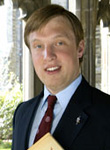CU trivia buff recounts live bear mascot, fictional Cornell rascals and the giant pumpkin prank
By Kristen Tauer

Cornell's first mascot wasn't merely a man in a bear suit but a live bear named Touchdown, gifted to the football team by an alumna in 1915. Touchdown traveled with the team to all of their games, staying with them in hotels and joining them on the field, said Corey Earle '07 at a talk March 29.
The year the live bear joined the team was also the first Cornell won a national championship in football, and 1939, the last year a live bear served as Cornell's mascot, was also the last year Cornell won a national football championship.
"It's not a new coach we need, it's a new bear," joked Earle, in presenting "Those Good Ol' Days on the Hill: Cornell History, Trivia and Legends" in the auditorium of Kendal at Ithaca retirement community. Earle, the 13th Cornellian in his family, has been collecting Cornell trivia ever since his freshman year; he worked as a reference specialist on Cornell history in the Rare & Manuscript Collections of Kroch Library before joining alumni affairs.

The football team, Earle noted, also influenced a food staple: Campbell's soup. In 1898, a Campbell executive attended the annual Thanksgiving game against the University of Pennsylvania, Earle said, and was so impressed by the team's red-and-white jerseys, the story goes, that he decided to use the colors for the labels on the cans.
Earle also recounted the long-lived tradition of Cornell students pulling pranks on campus. Narby Krimsnatch '56 (most recently responsible for the return of the stolen fiberglass dairy cow calf), for example, was a fictional character created in 1956 by a group of students, Earle said. Yet, Krimsnatch managed to get elected to class office, get tapped for secret honor society Quill & Dagger and even had a photo in the yearbook, Earle said.
Earle also described the history of the infamous giant pumpkin that was placed atop the clock tower in 1997. Although not confirmed, sources have attributed the stunt to local rock climbers. On whether the pumpkin was actually a pumpkin, one audience member noted, "The man who identified the pumpkin as a pumpkin is a resident of Kendal."
In talking about Cornell's history, Earle said that the first class to enroll at Cornell was made up of only 412 people -- the largest entering class in the nation at the time.
"Cornell is a pioneer across the board," Earle said. In addition to providing a place where anyone was welcome to pursue a higher education, an idea that was radical at the time, Cornell also had the first departments of electrical engineering, plant pathology and entomology in the country and was the first school to offer four-year programs in architecture and hotel administration.
Kristen Tauer '10 is a writer intern at the Cornell Chronicle.
Get Cornell news delivered right to your inbox.
Subscribe